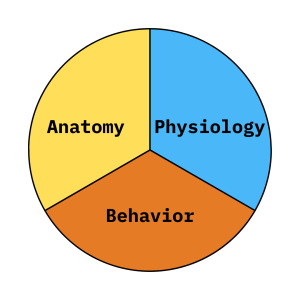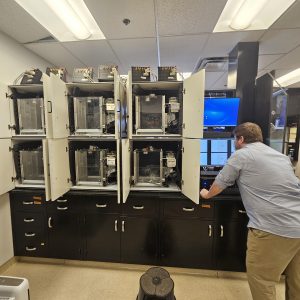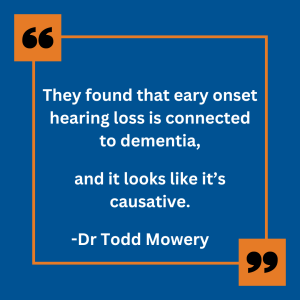Dr Todd Mowery and Justin Yao – Part 2
May 28, 2024
This is a continuation of our conversation with Dr. Todd Mowery.
Dr. Todd Mowery uses neuroanatomical, neurophysiological, and behavioral techniques to investigate how hearing loss and vestibular dysfunction impact downstream regions involved in cognitive processing.
He and Dr. Justin Yao were recently published in Frontiers in Neurology with their paper “Superior semicircular canal dehiscence and subsequent closure induces reversible impaired decision-making”. DOI: 10.3389/fneur.2023.1259030
 What drove the decision to collaborate with Justin Yao?
What drove the decision to collaborate with Justin Yao?
Justin is really focused on basic neuroscience. He is interested in how something works, and I am interested in what happens to it after it breaks. So, we work really well in that regard. I’m always telling him that he needs to add more clinical, translational aims, and he’s always telling me that you can’t have this clinical aim until you have the basic aim. We synergize with each other with that. When we were both recruited by Rutgers, we sat down and had a long conversation about how we were going to divide up the field.
We both have good career plans that are not the same, but they work in parallel to one another. We’re bringing in more neuroscientists that are interested in regions connected downstream of the auditory circuitry. I think the idea that you can work in one little structure for a 30-year career is over, so we’re moving forward with that in mind.
What’s your approach to neuroscience research?
 Anatomy, physiology, and behavior. Those three things are always going to be at the root of neuroscience.
Anatomy, physiology, and behavior. Those three things are always going to be at the root of neuroscience.
For a basic traditional neuroscience lab, once you have these approaches established, you can ask all kinds of questions. We’re really interested in how all these systems interact with the auditory circuit. Once we find a connection, it’s not hard for us to design an experiment to ask the next question. It’s just about putting the electrodes somewhere else, tweaking a behavioral paradigm, and adding a different kind of stimulation. We do a lot of neuroanatomical tracing to see how all these circuits are connected.
Once we do the anatomy, we can go back in with physiology and then create the behavior paradigms around the question we want to ask to determine the interaction between the regions.
What do you see as the next innovation in the field?
I think fiber photometry is the new kid in town that’s got everybody excited. We have to continue to innovate to keep up with everything. I think a part of that is technology. Photon-imaging is great, but it’s limiting in that you need a big piece of machinery, and your yield comes down. I think the next version of fiber photometry is going to be able to address these two issues. I’m waiting for the next version to emerge, which would hopefully be able to visualize activity deeper into the brain than we’ve gone and record from multiple connected regions at a time. These types of studies will be required if we want to take computer modeling of the brain seriously.
What are some of your ideas for your research moving forward?
 Justin is looking at the parietal cortex; I specialize in the striatum. We’re starting to look at how these super circuits work together, especially during vestibular disorders and hearing loss.
Justin is looking at the parietal cortex; I specialize in the striatum. We’re starting to look at how these super circuits work together, especially during vestibular disorders and hearing loss.
As the auditory circuits break down over time, all the connected circuits in other systems start to break down as well. Justin and I are going to be looking at that over the next 20 years. We have some noise paradigms where we deafen the animals to see how hearing loss affects those circuits and why dementia might be occurring subsequent to that. We have some hypotheses about far downstream systems like the hippocampus.
There’s another concept I thought about that could apply to the iCon system. We want to implant rodents with electrodes and record them 24 hours a day in their home cages. When they want to eat or drink, there’s a paradigm that they have to perform, and we could collect naturalistic data that way.
Why is this research important?
 Hearing loss affects the most people in the world. If you’re over 65, you have a 78% chance of having mild to severe hearing loss. All hearing aids do is amplify sound, and they worsen your hearing loss more quickly. A lot of people have hearing loss, but don’t get diagnosed until it’s moderate to severe and they can’t hear their partner or kids. They found that early onset hearing loss is connected to dementia, and it looks like it’s causative, so there’s a big push in the auditory field to start looking at these things.
Hearing loss affects the most people in the world. If you’re over 65, you have a 78% chance of having mild to severe hearing loss. All hearing aids do is amplify sound, and they worsen your hearing loss more quickly. A lot of people have hearing loss, but don’t get diagnosed until it’s moderate to severe and they can’t hear their partner or kids. They found that early onset hearing loss is connected to dementia, and it looks like it’s causative, so there’s a big push in the auditory field to start looking at these things.
We have lots of younger, earlier onsets of hearing loss. The problem is our world has become noisier. Almost anyone that’s been deployed in an active battle zone has hearing loss. People in industry are exposed to damaging noise levels every day for decades. Same thing with motorcycle riders, truck drivers, subway riders, airplane riders. Everyone wears headphones. Deaf people don’t have dementia because their circuits never developed with sound, so other inputs fill-in the space in a use-dependent effect. But reorganizational plasticity falls off as you get older.
I like to spread this information because dementia is very tangible. Everybody typically knows someone that’s had dementia or hearing loss. Sometimes the degradation can happen rapidly in the brain. It’s important to keep yourself spry. It’s like the internal voice starts to fall apart when you haven’t heard someone speak to you in a while.
Tags: customer spotlight
